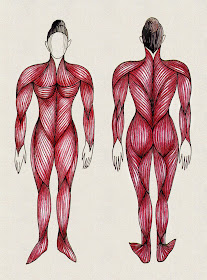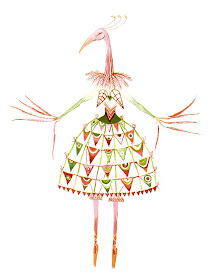Pages
▼
Saturday, May 29, 2010
"21-87" and "Look at Life"
From the National Film Board of Canada: "This short film from Arthur Lipsett is an abstract succession of unrelated views of the passing crowd. A commentary on a machine-dominated society, it is often cited as an influence on George Lucas's Star Wars and his conceptualization of "The Force."
As we explore the possibilities of storytelling, it is important to look backward and also explore the influences on contemporary storytellers. One of George Lucas' biggest influences before and during his time as a film student was Arthur Lipsett's "21-87" as seen in his first student film "Look at Life."
Monday, May 10, 2010
Kevin Mowrer: The Man Behind Meta-story

Kevin Mowrer has started a new web log as a part of his effort to move the storytelling conversation forward. Having recently had Kevin speak to a class of my students at RISD, and having worked with him on a variety of projects, I can't tell you how thrilled I am that he has started a web log of his own to share his powerful vision for the future of storytelling in entertainment media.
I encourage everyone who is currently following my web log to sign up to follow his by clicking HERE. I can assure you that you won't regret it.
Saturday, May 8, 2010
The “Willow” that Wasn’t
The sheer amount of art that has been produced for Lucasfilm projects is overwhelming in its quantity and quality. One of the artists, whose contributions to Lucasfilm’s archives are particularly exciting, is French master illustrator Jean “Moebius” Giraud.
When I was in college, a friend showed me a book that was a retrospective of Moebius’ diverse works for various clients over his long career. I was stunned when I came to a series of spreads exploring a rich fantasy world through pen and ink and watercolor. I was further surprised when I realized that these designs were commissioned by Lucasfilm for the film “Willow.” As an enormous fan of Moebius and as a huge fan of these sketches, it is impossible for me not to imagine what a film driven by these designs would have looked like.
Moebius shows himself to be a master of understanding George Lucas’ influences for this film, which included Akira Kurosawa’s Noh influenced samurai films. His use of a Noh theater mask for the character of Sorsha is one of my favorite decisions. Another example of Moebius’ playfulness as a creative thinker is his making the Kael character a purple beast with a tattoo of a green dragon on his forehead. Essentially, a monster who has a tattoo of a monster on him!












UPDATE: "Sequential Art Primer Part 3" has just been posted and includes images of the Moebius 'bande dessinée' work from his groundbreaking "Arzach." It may be viewed by clicking HERE
When I was in college, a friend showed me a book that was a retrospective of Moebius’ diverse works for various clients over his long career. I was stunned when I came to a series of spreads exploring a rich fantasy world through pen and ink and watercolor. I was further surprised when I realized that these designs were commissioned by Lucasfilm for the film “Willow.” As an enormous fan of Moebius and as a huge fan of these sketches, it is impossible for me not to imagine what a film driven by these designs would have looked like.
Moebius shows himself to be a master of understanding George Lucas’ influences for this film, which included Akira Kurosawa’s Noh influenced samurai films. His use of a Noh theater mask for the character of Sorsha is one of my favorite decisions. Another example of Moebius’ playfulness as a creative thinker is his making the Kael character a purple beast with a tattoo of a green dragon on his forehead. Essentially, a monster who has a tattoo of a monster on him!












UPDATE: "Sequential Art Primer Part 3" has just been posted and includes images of the Moebius 'bande dessinée' work from his groundbreaking "Arzach." It may be viewed by clicking HERE
For those of you who would like to watch Moebius draw, here is a video of him (now in his seventies) drawing on a Cintiq. Words do not do this man justice.
Tuesday, May 4, 2010
Two Women, Immaculate Character Design
In addition to my work lecturing on the use of symbols in character design and storytelling (which includes my presentations on my theory for approaching character design) I teach a course to college visual art students on character design called “Character Creation.” As such is the case, I rely heavily on presenting students with examples of character and visual design that is illustrative of the potential for diversity of thought and methodology.
One of the many qualities of the academic institution where I teach is the fact that a large majority of our students are women artists. As such is the case, our design and narrative work is constantly leading to engaging discussions on the issues these women want addressed by the stories and characters of the future. It has placed an extra emphasis on my tendency to actively seek out more diverse examples of artists whom, through their work and exploration, are effective role models of how to put into practice bold and uncompromising ideas that can evolve and redefine the conversation global culture is having.
Two women, who are incomparable as examples and without whom my curriculum would greatly suffer, are Eiko Ishioka (Cirque Du Soleil’s Varakei, Bram Stokers Dracula, The Cell, and The Fall) and Julie Taymor (Broadway’s The Lion King, The Magic Flute, Titus Andronicus, and Oedipus Rex). As visual thinkers and visionaries they are peerless, and their work possesses that rare ability to work within various industries and media while maintaining a strong auteur voice. Below are examples of both of their design drawings.
EIKO ISHIOKA (from "The Cell" and "Bram Stoker’s Dracula")






JULIE TAYMOR (from "The Magic Flute")








One of the many qualities of the academic institution where I teach is the fact that a large majority of our students are women artists. As such is the case, our design and narrative work is constantly leading to engaging discussions on the issues these women want addressed by the stories and characters of the future. It has placed an extra emphasis on my tendency to actively seek out more diverse examples of artists whom, through their work and exploration, are effective role models of how to put into practice bold and uncompromising ideas that can evolve and redefine the conversation global culture is having.
Two women, who are incomparable as examples and without whom my curriculum would greatly suffer, are Eiko Ishioka (Cirque Du Soleil’s Varakei, Bram Stokers Dracula, The Cell, and The Fall) and Julie Taymor (Broadway’s The Lion King, The Magic Flute, Titus Andronicus, and Oedipus Rex). As visual thinkers and visionaries they are peerless, and their work possesses that rare ability to work within various industries and media while maintaining a strong auteur voice. Below are examples of both of their design drawings.
EIKO ISHIOKA (from "The Cell" and "Bram Stoker’s Dracula")






JULIE TAYMOR (from "The Magic Flute")








Concept Design: It is NOT about rendering

concept•1550s, from M.L. conceptum "draft, abstract," in L. "(a thing) conceived,"
design•1540s, from L. designare "mark out, devise," from de- "out" + signare "to mark," from signum "a mark, sign."
The illustration featured above was created by George Lucas in November of 1974* as a way of illustrating to artist Ralph McQuarrie the formal qualities he desired in the universe of Star Wars. In this simple sketch are some of the most iconic designs of the film saga that would later be translated across countless different media.
This simple doodle is a perfect example of the visual immediacy great concept design should possess. This is not to undermine the extraordinary contributions McQuarrie made to the visual aesthetic of the Star Wars universe or in any way minimize his abilities as a designer. However, the lesson here is that concept art is not about rendering or style, but about the manifestation and communication of ideas.
There is a reason why the Star Wars universe can both communicate with adults and be depicted in crayon by young children. The wholeness of great design can be understood easily, assimilated instantly, and retransmitted persuasively.
*J. W. Rinzler, “The Making of Star Wars” New York: Ballantine Books, 2007
